By: Anna Faktorovich, PhD
–June 29, 2016
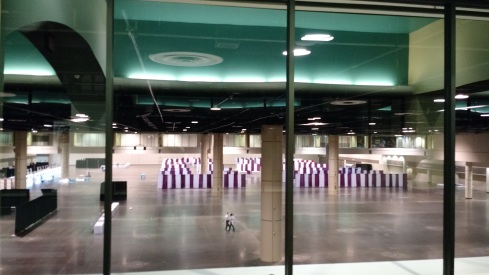
I returned from this 4-day trip at 11pm yesterday, June 27, 2016, having departed at 7am on the 24th. The drive was seven hours to get there and around eight to get back. I brought food with me for this trip for the first time to avoid eating at the nightmarish fast food establishments I’ve been experimenting with in the previous 2-3 trips. This worked out partially, but then I started thinking about this as a goal for the trip, and managed to only buy once bottled ice tea across the entire adventure, on the way back. Other than the food I brought with me, I ate entirely at meetings at ALA, and because it’s so humongous, there were enough meetings with food in them for me to feel pretty full. Though on the second or third evening the reception I first attended only had chips, so it was a bit of a venture across a couple of the participating hotels before I finally found a reception that was serving dinner-like items that filled me up. The breakfast I was eating at Extended Stay was so bad that it kept me pretty repelled from food. On the other hand, the Orange County Convention Center is the most spaced apart venue I’ve ever seen in all my decades of participating in conferences. There were five neighboring hotels that held some of the meetings, as well as four concourses that were part of the center, so that getting from one meeting to another, was typically a twenty-minute walk, and I had to take at least eight of these walks daily, for a total of around 2-3 hours of walking daily, and this with my car parked relatively close to the exhibit halls. I took a new pair of business shoes with me for this trip, so I developed a couple of callouses on my heels, which I hope will subside before my loan mowing and shopping exercises in the following couple of days. So, all this walking made me make some irrational food-related decisions. I’m sure if I wasn’t so tired, I would’ve given in and eaten in a hotel restaurant, but the memory of my last few hotel restaurant eating attempts kept me away. The free reception, breakfast, etc. food offered as part of the conference varied from being very good to pretty bad, but since it was free at least I did not have to argue with the manager that it should be free. In total, if I don’t count the motel stay, the trip to Orlando cost me $100 for gas, food, parking and all other expenses.
The main point for the trip was to sell the books I have published with Anaphora to librarians, but as at SIBA and other festivals and conventions that promise over 10,000 visitors to the tables, these statistics were exaggerated, and very few of the people that went by my table were actual acquiring librarians. Those that stopped by frequently wanted free books for their impoverished library, or to take a copy of my catalog or books for review. Twenty books were stolen on the second day, including five hardcovers, and my neighbors kept working to convince me that it was not theft but that the visitors to my booth thought that whatever was on the exhibit table was free, as if they had taken them or encouraged visitors to take them when I was away from the table. I was tempted to file an official complaint, but since unlike in Miami it was not a vandalism of my entire exhibit, but merely a theft of the best books I’ve published, which now could not be shown to any of the visitors that saw the exhibit after the morning on the second day, I decided to let it go.
I already had too many other things to worry about. Extended Stay had an incredible number of problems and as I complained about these, the staff started retaliating by creating more serious problems, stressing this fact with constant threats. I wrote a long review that list these issues that should go up on TripAdvisor shortly; my review of the Miami motel I stayed in has received 3,000 views either per week or in total since my stay. Basically, there was a bug, there was a jumping (smoking, and skunk-nurturing) acrobat upstairs, the bottom of the tub was bent in, the towels and everything else stank, the air conditioner was either too productive or off, and the staff deactivated my key nightly, so that I had come to the front desk every night for them to fix this problem. They also failed to take off the $50 coupon I received via their website, despite the fact I mentioned it to them when I arrived, and simply charged me $50+ more and my card is not showing any deductions a day after I left. They promised a free night at a different Extended Stay, but I contacted their corporate office about this because they kept lying, stealing and threatening so much that I doubt they would actually process the discount unless I went above their heads.
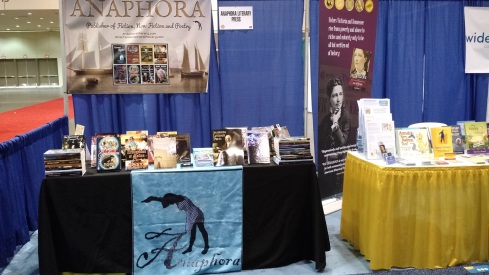
One interesting thing I tried on this trip is using the docks to offload and reload my books. After I complained about the one-walk-in and other restricting policies, I was told I could do this for free. It took me a while to find the entrance because it was at the furthest end behind the building. There were also hundreds of all sorts of golf carts to giant trucks going around that space, at well over the 10mph limit. I parked a few sections away from where I was supposed to, but the trip to get my cart, chairs etc. over was a lot shorter than if I had parked in the distant lot and then attempted to drag them all in. Another challenge was affixing the giant Anaphora sign to the back of the booth; I nearly pulled down the entire line of polls and drapery down as I was working to hold onto my balance. As usually happens, when I’m attempting a trick like this, dozens of people just sat or stood around, staring at me, and giggled.

I got around 40 review copies that I will review in the next PLJ issue from the different exhibiting publishers, so when I was re-loading the car, I had to make two trips to it. But these two trips only took a couple of minutes what held up my departure by 50 minutes was standing still in a line of 15 cars and around 4 trucks by the dock entrance, as the guy at the gate simply refused to let anybody in. I tried to take a nap, but there were occasional movements by a couple of feet every 10 minutes so it was just a bit of shut eye, still a break before the drive back.
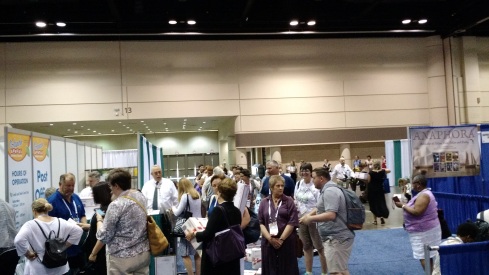
There was also a 200-person long line to the USPS (similar to breadlines back in the USSR in the early nineties before my departure), in the corner directly next to my booth, which took over an hour and a half for one disgruntled customer to complete, so I’m glad I at least did not have to ship my 150 books anywhere.
I had enlightening meetings with editors from the Library Journal, Publishers Weekly, and Booklist and explained my line of books to them. As usually happens when I call or contact them, they all said they will do their best to review one of Anaphora’s titles, but to-date none of these three publications have ever reviewed an Anaphora release, and I’ve submitted over 60 books to PW. Library Journal reviewed “Formulas of Popular Fiction” upon its release with McFarland, but they did not touch similar scholarly books of my own that I released with Anaphora. One of them mentioned that I should send a paperback galley and then a hardcover upon release, but this would mean I have to ask authors to pay 2X more per review copy submitted, and considering that some of these want 2 of each, it’s really 3X more, or a difference between $22.50 for 2 books and $67.50 for 4 books. How did this review process come into being, and what purpose can this wastefulness serve other than to push smaller publishers out of competition. And yet, since reviews from this elite group of reviewers is the final frontier for Anaphora, I’ll do my best to follow whatever guidelines I’m offered and will work to help Anaphora’s writers understand these guidelines because of the leap in sales that happens for any book reviewed in these venues.
I also had interesting talks with international distributors, and various other parties that might lead to different expansions for Anaphora if they develop in positive ways after I follow-up.
But the reason for this report from the convention is to share some of the photographs I took while I was there that might be of general interest.
The ALAPlay event at 7:30pm on Friday evening was a curious way to start my research of all things unusual at ALA. I contacted the organizer in advance and asked if I should design a game to demo at the event, but he told me that this was not what the event was for. Surely enough, when I arrived, I discovered that half of the people there had sketchy demos that they made to sell them to the game publishers that were also at the event, and made some deals on the spot. Since I did not have a demo to sell, I used the time to ask if I could help any of the developers publish their games, and perhaps something will come of this. I also did some research on the top games that were using this event to demonstrate their top new game releases, including Paizo, Mayfair, HABA, and Konami. Whenever I’d come to a table somebody would try to draw me into the game, but it was easier for me to ask the developers and marketers about the business and design of new games than to engage in learning the convoluted rules of the games on display. Near the end of this tour, somebody mentioned that they needed more reviews for their game, and I had to confess that if I reviewed any of the games on display (from top publishers and the new pitchers), the review would be extremely negative. I did not play many games as a child, and I think my tastes have become much more critical since that time. It’s so easy to print just about any sort of game today, and yet so many of these board games are repetitive in design, structure, etc. that they devolve their players. Finding out about how this problem takes place really made me want to try to create a game of my own, and there was a game publisher there that seemed a bit interested – so I’ll do a pitch after I settle in.


I came uncharacteristically early for the Maya Penn talk, which started at 3:30pm on Saturday, and sat down on the front row, immediately beginning to complain to my neighbor, who seemed so uncomfortable with the joke that I asked if I had once again sat in the family section. The woman sitting next to me explained that she was the editor of a membership-only ALA magazine and had just done an interview backstage with Maya, beginning this explanation by stressing that she was not related to her. I complained that I had been told I would not have special backstage privileges regardless of if I applied for a press pass or not, so she said that I could just try to go back there, but that the talk was set to begin in a few minutes. Naturally, I gave it a try out of curiosity on what the backstage looked like. I knocked on a giant side door, but there was no answer. I slowly creaked the door open, and there was a long hallway behind it. I walked down it until I heard some voices in one of the side halls. As I was approaching, slowly, the voices suddenly stopped, to avoid scaring the organizers I said, “oy vey,” as if from the struggle of walking up there. On this note, the two ALA organizers that were in there with her came out to ask what I was doing back there. So, I gave them my card, and mentioned that I wanted to do an interview with Maya, and they said they’d pass the card on to her. I walked back into the auditorium, took some pictures, and as usual with me lately, listened to around 10 minutes of it before I could not explain to myself why I might remain, and left to carry on with my day. I was sure that was the end of it because celebrities never call or email when you give them your card, as they expect you to call them.
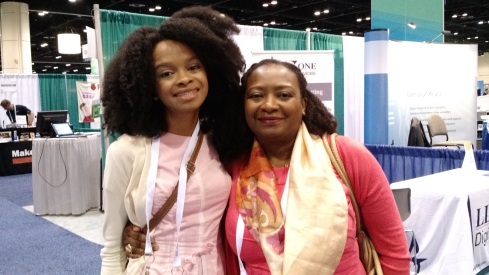

Then, on Sunday, as I was making a round of the exhibit hall, I saw her again, standing dreamily in the middle of the isle. I explained that I was the one that passed the card onto her, and she said she would like to do an interview, giving me her card. Her mom jumped out of nowhere after my first sentence – I guessed it was her mom because she looked very concerned that her daughter was speaking with a stranger. I took photos of them together because she looks very different on the stage alone than when she’s standing with her mom, as if her real age shows through. Maya Penn started a clothing design company when she was very young, and it has been followed by various other ventures, such as developing animated films, doing three popular TEDWomen Talks, and other projects in activism and coding. It remains to be seen if this interview will materialize…
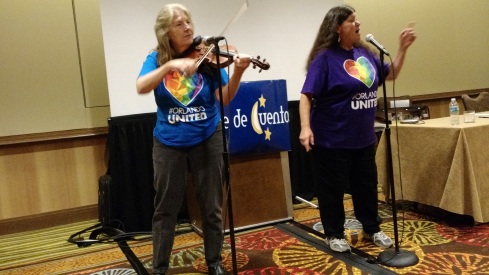
A re-energizing event on Saturday at 8pm was “Noche de Quentos,” a storytelling celebration with local talent. A set of Latina storytellers told stories in variations between English, Spanglish and Spanish that were either folktales, or modernized tales, either original or retellings of well-known performance pieces. It was a very colorful performance, and so comic and dramatic that it kept the excited audience’s attention. Nancy Crockford played the violin while Kim Rivers told a story about a beautiful cockroach searching for a husband.

Oralia Garza de Cortes told the story of three brothers’ attempt to save an enchanted princess.
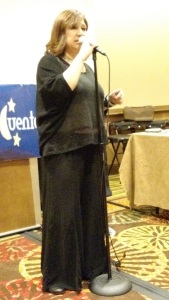
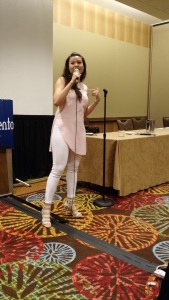
Lucia Gonzalez, a children’s book award winner was the Mistress of Ceremonies and did a great job explaining the significance of storytelling in Latino communities.

On Sunday at 8am, there was a light breakfast as part of “Literary Tastes Celebrating the Best Reading of the Year,” which included a talk/ reading and a signing from best-selling authors, including: Joy Harjo (Crazy Brave: A Memoir), Karin Slaughter (The Kept Woman: A Novel), Naomi Novik (Uprooted), Jim Shepard (The Book of Aron), and James Hannam (Delicious Foods: A Novel). The most memorable talks were from the latter two. James Hannam began his presentation by complaining that he had to follow the award-winning Shepard, and then he explained jokingly that his book begins with a guy attempting to take a long roadtrip with both of his hands severed. Hannam then explained that the book is about modern day slavery, and about the enslavement of a group of individuals at the Delicious Foods company, where they were forced into slave labor. I’ll review this set of books later on in more detail. Shepard was striking because his book is about a boy smuggling needed food and supplies before and during the Holocaust in Warsaw. I was allowed to grab the review copies after I finished breakfast without waiting for the signing, as that stage takes at least an hour with over 100 visitors in the room (I have too many signed galleys that I can never sell already).

At 11am on Sunday, I stopped by and listened to a good deal of a talk by Edward Meyer, the Vice President of Ripley’s Believe It or Not! He offered some interesting details about Ripley’s early cartooning career, and showed archival photographs that I had asked about in the interview I did with him prior to ALA via email, so it was the most engaging talk I heard at the ALA. He is probably the only speaker I heard at ALA that was offering new information, rather than recycling clichés.

I had an early evening on Sunday, and woke up early on Monday, so I managed to attend a 7am Independent School Library meeting. It began pretty well when the organizer told me that she could email a list of a hundred or so publications in addition to the top five she could name that she typically uses to select books for her library. She also gave me the great news that Baker & Taylor has been purchased by Follett, which means that their embargo on books printed with Ingram might finally come to an end. BT charges $300 or so per Ingram title to add them to their catalog, which is the only one preferred above all others by librarians that give talks at ALA, SIBA, etc.) I spoke with BT and Follett later that day, and asked them to notify me if/ when a change will take place, so that I could forward the good news to my writers. But then, a woman entered with a baby that immediately pooped in its pants, emitting a very strong odor across the room. The baby also proceeded to toss a bottle with baby food that was left within his reach across the room. And the woman fed him some of the Dunkin Donuts that were provided at this meeting, which he briskly smothered across the black covers on the conference tables, painting a composition that’s visible in this photo. All this might have disconcerted the librarians because their discussion started running in circles, so that each of them was either asking for them to actually get something done at the meeting, or commenting about dwindling membership, low budgets, and their inability to get things done. Maybe it was the smell or the early hour, but I got a bit sleepy, and my head dropped down to the relatively clean portion of the table and I got a few minutes of shut eye before I moved on to the next meeting that started in the middle of that one.


Jazz Jennings (now 15 years old) gave an interview with a journalist in the auditorium in the morning, and fumbled a great deal in her replies, saying “whatever” and “you know what I mean” a lot, and blaming her absentmindedness on the early hour. Jennings “transitioned to life as a girl” when she was five, and in the following year she interviewed with Barbara Walters, and with most other high profile publications before starting her own YouTube channel, picture book, and TLC TV Series, I Am Jazz. She was identified as having a “gender identity disorder” when she was four; whereas, the average age for this diagnosis is forty-two. When she talked nonchalantly and with a smile about the Orlando gay nightclub shooting, I got a chill and suddenly did not feel at all uplifted by her story. Only in America can a child be diagnosed with a mental disorder when she first begins speaking and says, “I want to wear a dress.” The correct answer for her parents should have been, “no,” not, “let’s take her to a psychiatrist to check if he’s really a she.” During the interview she refrained from talking about the real issues that transgendered youths face, and bullying, which she did comment on, is last on this list (in my opinion). At one point, she asked the interviewer if he would find it rude if people asked him if he had an operation on his elbow, when he brushed against a topic related to her potential gender re-assignment surgery. I could not tell if Jazz has head breast implants, but if she has had any major surgery or if she is taking drugs to change her body even at 15, and I shudder to think what it would mean if she started at 4, then her parents and all the people that fail to fully question her about her choices are negligent, and are setting her up for various diseases associated with the drugs impactful enough to change gender characteristics. And if Michael Jackson’s results are any indication plastic surgery is certainly not something a health-conscious teen should be considering. The minimum age for consent to sex reassignment surgery in the US is 18, and yet Jazz has looked and sounded like a girl in media appearances for years, a feat that seems impossible without surgical assistance. In the same interview she talked about wanting to concentrate on school work instead of on “drama,” but how could she have been learning in the last ten years, the peak years for mental development, if she was hospitalized for gender re-assignment surgeries between all of her media appearances, and other distractions. I support the rights of people to change their gender if they want to, but the media has failed to be as concerned about her wellbeing as any sympathetic observer should be.
I hope my descriptions of the events I visit are helping some of my readers choose which conventions are right for them, and which ones should not be attempted.




Leave a comment